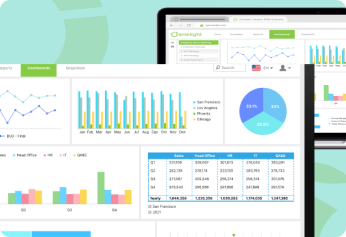For finance teams managing subscription-based businesses, few metrics matter more than Annual Recurring Revenue (ARR). This predictable revenue stream serves as the backbone of financial planning, investor relations, and strategic decision-making. Yet many finance professionals struggle with accurate ARR calculations and interpretation, leading to flawed forecasts and missed growth opportunities.
This guide walks you through everything you need to know about ARR, from basic calculations to advanced tracking strategies. Whether you're a CFO evaluating business performance or a finance director building next year's budget, understanding ARR will transform how you approach financial planning.
What is Annual Recurring Revenue (ARR)?
Annual Recurring Revenue represents the predictable, recurring revenue your business expects to receive from customers over a 12-month period. Unlike one-time purchases or variable fees, ARR focuses exclusively on subscription revenue that repeats annually.
Think of ARR as your business's financial heartbeat. A SaaS company charging $100 per month per customer has an ARR of $1,200 per customer. A consulting firm with a $50,000 annual retainer agreement contributes $50,000 to ARR. The key is predictability- revenue you can reasonably expect to continue.
ARR differs from total revenue because it excludes:
- One-time setup fees
- Professional services revenue
- Variable usage charges
- Non-recurring consulting fees
This focus on recurring elements gives finance teams a clearer picture of sustainable business growth and helps investors evaluate long-term potential.
How to Calculate ARR
Calculating ARR requires a systematic approach to ensure accuracy and consistency across your organization.
Basic ARR Formula
ARR = Monthly Recurring Revenue (MRR) × 12
Step-by-Step Calculation Process
Step 1: Identify all recurring revenue streams List every subscription, retainer, or recurring payment your customers make. Include monthly subscriptions, quarterly payments, and annual contracts.
Step 2: Convert all recurring revenue to monthly amounts
- Monthly subscriptions: Use as-is
- Quarterly payments: Divide by 3
- Annual contracts: Divide by 12
Step 3: Sum your Monthly Recurring Revenue (MRR) Add all monthly recurring amounts to get your total MRR.
Step 4: Multiply MRR by 12 Your final ARR = Total MRR × 12
Practical Example
Let's say your company has:
- 50 customers paying $200/month = $10,000 MRR
- 20 customers paying $600/quarter = $4,000 MRR ($600 ÷ 3 × 20)
- 10 customers with $12,000 annual contracts = $10,000 MRR ($12,000 ÷ 12 × 10)
Total MRR = $10,000 + $4,000 + $10,000 = $24,000 ARR = $24,000 × 12 = $288,000
Common Calculation Pitfalls
Avoid these mistakes that can skew your ARR:
- Including one-time fees or setup charges
- Counting variable usage revenue
- Double-counting customers who upgrade mid-period
- Ignoring churn adjustments
ARR vs. Monthly Recurring Revenue (MRR)
Understanding when to use ARR versus MRR helps you choose the right metric for different business situations.
|
Aspect |
ARR |
MRR |
|
Time Frame |
Annual view (12 months) |
Monthly view (30 days) |
|
Best For |
Long-term planning, investor reporting |
Short-term tracking, operational decisions |
|
Granularity |
Less detailed, broader trends |
More detailed, immediate changes |
|
Investor Preference |
Preferred for funding discussions |
Used for monthly board reports |
|
Planning Horizon |
Strategic planning (1-3 years) |
Tactical planning (1-6 months) |
When to Use ARR
ARR works best for:
- Annual budgeting and forecasting
- Investor presentations and fundraising
- Valuation discussions
- Long-term strategic planning
- Comparing year-over-year growth
When to Use MRR
MRR is more useful for:
- Monthly performance tracking
- Identifying short-term trends
- Operational decision-making
- Sales team performance evaluation
- Quick course corrections
Most successful finance teams track both metrics, using MRR for day-to-day operations and ARR for strategic discussions.
Why is ARR Important?
ARR serves as a critical business health indicator that influences everything from daily operations to major strategic decisions.
1. Financial Planning and Forecasting
ARR provides the foundation for reliable financial forecasting. When you know your recurring revenue base, you can:
- Build more accurate annual budgets
- Predict cash flow with greater confidence
- Plan hiring and expansion timing
- Set realistic growth targets
2. Investor Relations and Valuation
Investors use ARR to evaluate business sustainability and growth potential. Companies with higher ARR typically receive better valuations because recurring revenue is more predictable than one-time sales.
3. Business Performance Measurement
ARR helps you measure:
- Customer lifetime value
- Revenue growth trends
- Market penetration success
- Product-market fit strength
4. Strategic Decision Making
Finance leaders use ARR to guide:
- Pricing strategy adjustments
- Customer acquisition investments
- Product development priorities
- Market expansion decisions
A healthcare software company, for example, might discover that their $2.5M ARR is growing 40% year-over-year, justifying increased investment in sales and marketing to accelerate growth.
Common Mistakes with ARR
Even experienced finance teams make ARR calculation errors that can mislead stakeholders and derail planning efforts.
1. Including Non-Recurring Revenue
Mistake: Adding one-time implementation fees, training costs, or consulting revenue to ARR calculations.
Solution: Create separate revenue categories for one-time and variable income. Only include truly recurring subscription or retainer fees in ARR.
2. Mishandling Customer Upgrades and Downgrades
Mistake: Double-counting revenue when customers upgrade mid-period or failing to adjust for downgrades.
Solution: Track net ARR changes monthly. When a customer upgrades from $100 to $200 monthly, add $100 to ARR, not $200.
3. Ignoring Churn Impact
Mistake: Calculating ARR based on current customers without accounting for expected churn.
Solution: Use net ARR that factors in both new customer additions and churned customer losses.
4. Inconsistent Time Period Calculations
Mistake: Mixing different time periods or failing to normalize contract lengths.
Solution: Always convert to monthly amounts first, then multiply by 12. Use consistent calculation methods across all revenue streams.
5. Overcomplicating Multi-Year Contracts
Mistake: Counting a 3-year, $36,000 contract as $36,000 ARR instead of $12,000 ARR.
Solution: For multi-year contracts, divide the total value by the contract length to get annual amounts.
Best Practices for Tracking ARR
Accurate ARR tracking requires systematic processes and regular validation to ensure data reliability.
1. Establish Clear Revenue Classification Rules
Create documented guidelines for what counts as recurring revenue. Train your team to distinguish between:
- Subscription fees (include)
- Professional services (exclude)
- Usage-based charges (exclude unless predictable)
- Maintenance contracts (include)
2. Implement Regular Data Audits
- Monthly Reviews: Check for data entry errors, missing contracts, or classification mistakes.
- Quarterly Deep Dives: Validate ARR calculations against actual revenue, review contract changes, and update forecasts.
- Annual Reconciliation: Ensure ARR tracking aligns with audited financial statements and investor reports.
3. Use Integrated Financial Systems
Manual spreadsheet tracking becomes unreliable as businesses grow. Consider tools that:
- Connect directly to your billing system
- Automatically categorize revenue types
- Track customer lifecycle changes
- Generate consistent reports
4. Track ARR Components Separately
Monitor different ARR segments:
- New customer ARR
- Expansion ARR (upgrades)
- Contraction ARR (downgrades)
- Churned ARR (lost customers)
This breakdown helps identify growth drivers and problem areas more clearly.
5. Align ARR Tracking with Business Strategy
Ensure your ARR metrics support strategic decision-making by:
- Segmenting by customer size, industry, or product line
- Tracking cohort-based ARR retention
- Monitoring ARR per employee or per sales rep
- Comparing ARR growth to customer acquisition costs
ARR in SaaS Companies
Software-as-a-Service companies rely heavily on ARR for performance evaluation and strategic planning, making accurate tracking essential for success.
1. SaaS ARR Calculation Nuances
SaaS businesses often have complex pricing models that require careful ARR treatment:
- Freemium Models: Only count paying customers in ARR calculations. Free users don't contribute to recurring revenue until they upgrade.
- Usage-Based Pricing: Include predictable usage charges but exclude highly variable components. A company with consistent $500 monthly usage might include this in ARR, while unpredictable spikes should be excluded.
- Multi-Product Subscriptions: Track ARR by product line to understand which offerings drive growth and which need attention.
2. SaaS-Specific ARR Metrics
- ARR Growth Rate: Month-over-month and year-over-year ARR growth percentages help evaluate business momentum.
- Net ARR Retention: Measures how much ARR you retain from existing customers, including upgrades and downgrades. Rates above 100% indicate expansion revenue exceeds churn.
- ARR per Customer: Helps evaluate pricing strategy effectiveness and identify upselling opportunities.
3. Using ARR for SaaS Decision Making
SaaS companies use ARR to guide:
- Pricing Strategy: If ARR per customer is declining, it might signal the need for price increases or better upselling.
- Customer Success Investment: Low ARR retention rates justify increased customer success spending to reduce churn.
- Sales Team Structure: ARR growth patterns help determine whether to focus on new customer acquisition or account expansion.
- Product Development: ARR by product line reveals which features drive the most recurring revenue value.
A SaaS company might discover that their enterprise customers contribute 70% of ARR despite being only 20% of customers, leading to increased focus on enterprise sales and success teams.
Streamline Your ARR Tracking with Modern FP&A Tools
While understanding ARR concepts is crucial, manual tracking becomes increasingly difficult as your business grows. Finance teams often find themselves spending countless hours consolidating data from multiple systems, checking for errors, and creating reports—time that could be better spent on strategic analysis.
Modern financial planning and analysis platforms can transform how you track and analyze ARR. Limelight helps finance teams move beyond spreadsheet-based ARR tracking with automated data integration, pre-built templates, and real-time reporting that scales with your business.
Ready to simplify your ARR tracking and spend more time on strategic planning? Book a demo to see how Limelight can help your finance team work more efficiently.
Table of Contents
Ready to put an end to outdated FP&A?
Get a perzonalized demo


